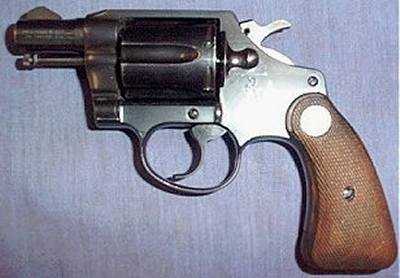

The grip panels were plastic in 1947, but were changed back to wood starting in 1955 (first with a silver-tone Colt medallion, and later a gold-tone). The right side frame screw has no locking pin, and the rear half of the front sight is a serrated ramp. The cylinder latch was smooth, and the trigger spur serrated.

The ejector-rod was longer and had a groove in its knurled tip a three-inch-barrel variant was offered, with a yet longer ejector rod. A rounded butt on the metal frame became standard in 1933, but pieces with the original square butt (like that of the Police Positive Special) continued to be produced into the 1940s. Other distinctive features included a shorter ejector rod with an ungrooved, knurled tip a checkered hammer spur and cylinder latch, a "half-moon"–shaped front sight, and an overlapping screw and locking pin set-up on the right side of the frame.
COLT AGENT 38 SERIES
Compared to later production models, the First Series used a narrower frame, with reduced clearance between the frontstrap of the gripframe and the rear of the trigger guard. The First Series was produced from 1927 until 1946. Ĭolt's Detective Special went through several issues or series. The Detective Special proved to be an instant success and was made until 1995. Even after the introduction of the Detective Special in 1927, Fitz continued to make custom revolvers for special clientele.Ī Colt Detective Special, Second Series on displayĬolt was so impressed with the Fitz Special that they decided to produce a sightly less radical version, the Detective Special, which is simply a shortened and somewhat streamlined Colt Police Positive Special. The Fitz Special was the precursor to the modern snubnosed revolver and specifically the prototype for the Colt Detective Special, the first production two-inch snubnosed revolver. The halved trigger guard facilitates quick trigger acquisition, even for shooters with large fingers or gloves.Īlthough historians disagree, it's believed that somewhere between 40 and 200 Fitz Specials left the Colt factory, made from various Colt revolvers, by Fitzgerald himself. Reshaping the hammer and the butt allows the gun to be drawn quickly with little risk of the weapon snagging on clothing. 38 Special Colt Police Positive Special revolver, by shortening the barrel to two inches, shortening the ejector rod, bobbing the hammer spur, rounding the butt, and removing the front half of the trigger guard. John Henry Fitzgerald, an employee of Colt Firearms from 1918 to 1944, first came up the Fitz Special snubnosed revolver concept around the mid 1920s, when he modified a.

Īlthough the Detective Special proved to be an instant success when first introduced, lackluster sales saw the elimination of the Detective Special from the product line in 1995. The Detective Special uses a slightly smaller frame than the Colt Official Police or Smith & Wesson Model 10 (K-Frame) revolvers, but is larger than the five-shot Smith & Wesson Model 36/ Model 38/ Model 42 (J-frame) revolvers. 38 Special, considered to be a powerful caliber for a concealable pocket revolver of the day. It was designed from the outset to be chambered for higher-powered cartridges such as the. Introduced in 1927, the Detective Special was the first short-barreled revolver produced with a modern swing-out frame. Made by Colt's Manufacturing Company, this model revolver, as the name "Detective Special" suggests, was intended to be a concealed weapon used by plainclothes police detectives. The Colt Detective Special is a six-shot, carbon steel framed, 2" or 3" barreled, double-action revolver, and the first example of a class of firearms known as "snubnose revolvers". A Colt Detective Special, Fourth Series, with rubber grips and a shrouded ejector rod


 0 kommentar(er)
0 kommentar(er)
